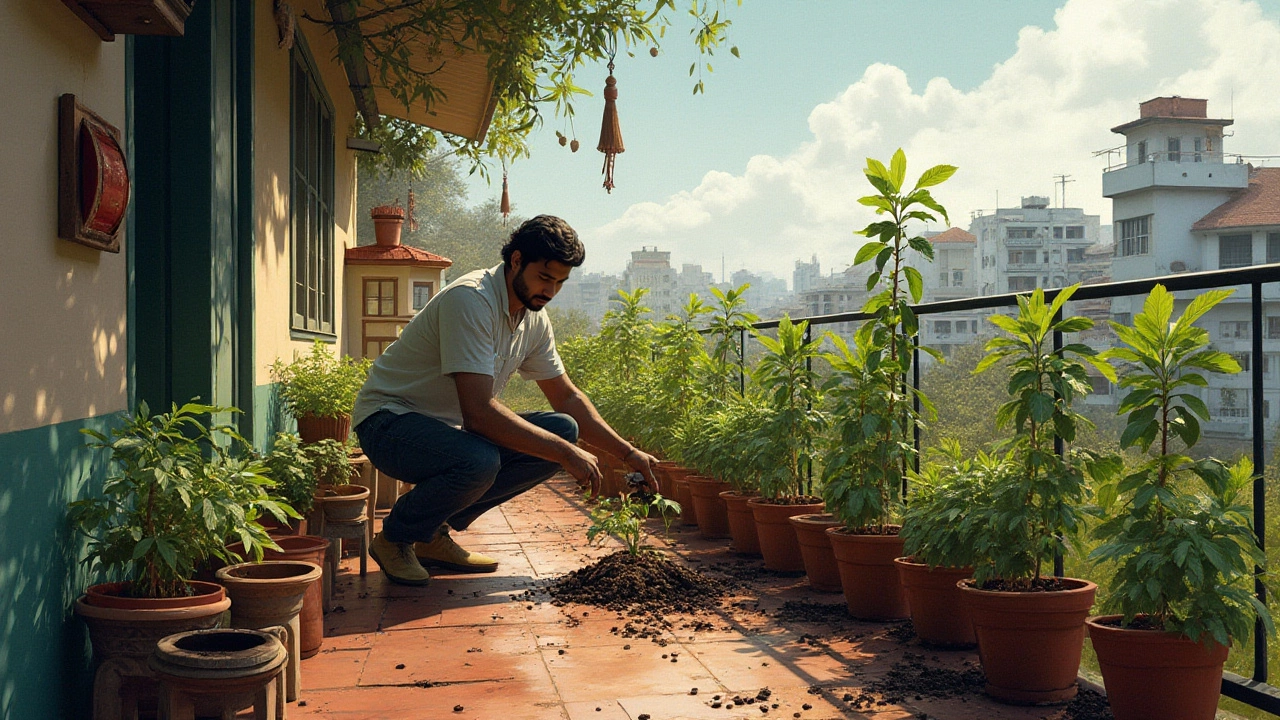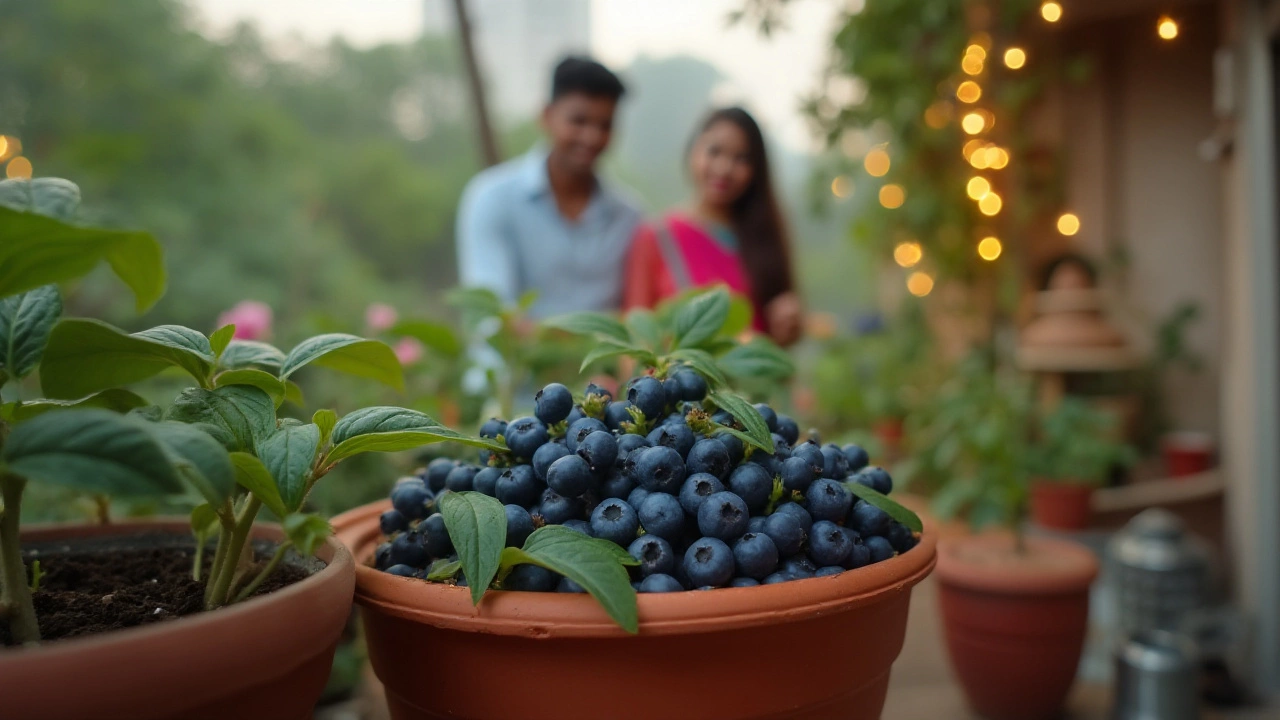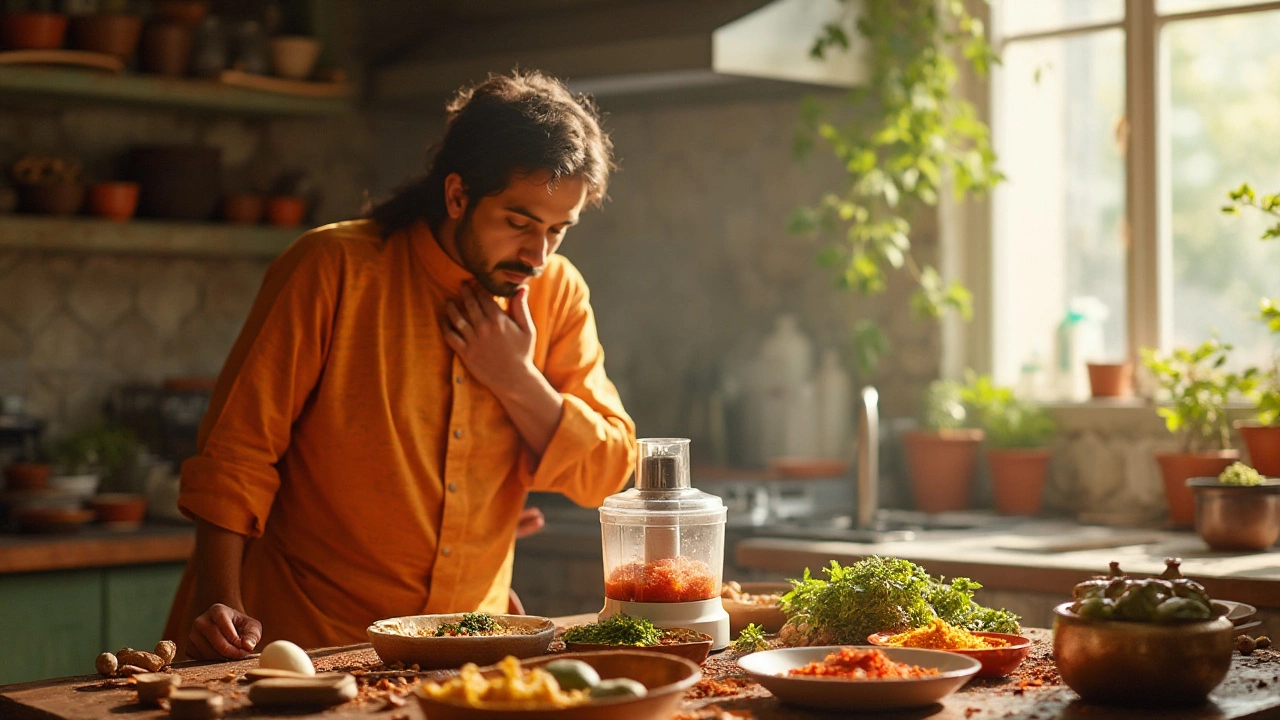Growing Blueberries on Your Apartment Balcony: A Practical Guide

Imagine stepping outside to your very own balcony garden, picking the freshest blueberries, and enjoying them right away. It sounds magical, doesn't it? Those living in urban apartments needn't just dream about this. With a bit of planning and effort, you can transform your balcony into a bountiful blueberry patch.
While traditional gardening might seem out of reach, container gardening bridges that gap, letting you bring the joys of nature into high-rise settings. Key to success is understanding the needs specific to blueberries, from the variety that will thrive in a container, to the soil and sunlight requirements. These are the first steps toward sustainable and rewarding urban gardening.
- Picking the Right Blueberry Variety
- Preparing Containers and Soil
- Planting Your Blueberries
- Caring for Balcony Blueberries
- Troubleshooting Common Issues
Picking the Right Blueberry Variety
Choosing the ideal blueberry variety is the foundation of any successful balcony garden. Blueberries aren’t one-size-fits-all, and selecting the right kind makes all the difference, especially in limited spaces. When you're restricted to a balcony setting, some varieties are better suited than others due to their size and growth behavior. Space is a premium commodity on a balcony, and finding compact varieties like the ‘Top Hat’ or ‘Jelly Bean’ can make efficient use of available area. These varieties are known for their small stature, typically reaching about two feet in height, making them perfect candidates for container gardening. Unlike their larger counterparts, these compact bushes produce a satisfying yield while taking up minimal space. A popular choice among urban gardeners, they ensure those delicious, home-grown blueberries are within arm's reach without sprawling over your precious space.
The climate plays a pivotal role in choosing the right variety, too. Blueberries are traditionally grown in cooler climates, but certain types can adapt to warmer regions. For instance, the ‘Sunshine Blue’ variety is remarkably heat-tolerant. This means even if your apartment swelters under the midday sun, there’s still a place for blueberries in your life. Alternatively, the ‘Patriot’ or ‘Northcountry’ blueberries are known to withstand colder climates, extending the possibility of cultivation in areas often deemed too chilly for growing fruits. Both varieties are hardy and can survive frosty conditions, opening them up as a possibility for northern growers.
Nutrient needs and soil conditions also present critical considerations for variety selection. Blueberries demand acidic soil, a non-negotiable when it comes to reaping a healthy harvest. NASA scientists found that the optimal soil for blueberries should have a pH of 4.5 to 5.2, which facilitates nutrient uptake and keeps your plants thriving. Varieties such as ‘Legacy’ and ‘Pink Lemonade’ can be particularly forgiving if the pH doesn’t entirely match the textbook recommendations, providing a degree of flexibility for novice gardeners. That said, providing the perfect soil environment ultimately leads to stronger, more productive plants.
"For maximum yield and healthiest plants, choosing the right variety for your region is essential," advises Jane Thompson, a renowned horticulturist with decades of experience in container gardening. Her words underpin the importance of research and planning before planting your first bush.Another consideration is pollination requirements. Some blueberries are self-pollinating, which means they don’t rely on cross-pollination from other plants. This factor eases the gardening process on a balcony, where space for multiple plants might be constrained. The likes of ‘Sweetheart’ and ‘Pink Champagne’ perform well independently, eliminating the need for a neighboring pollinator. However, keep in mind that having two variations nearby often increases fruit size and yield.
| Variety | Growth | Climate Suitability |
|---|---|---|
| Top Hat | Compact | Moderate |
| Sunshine Blue | Medium | Warm |
| Patriot | Tall | Cold |
Preparing Containers and Soil
The first step in cultivating a thriving blueberry plant on your balcony is selecting the right containers. The choice of container isn't merely a matter of aesthetics; it's crucial for the health and productivity of your plants. Ideally, you'll want a pot that is at least 12 to 18 inches deep and wide. This size allows the roots to spread comfortably and ensures sufficient soil volume to retain moisture. Lighter-colored pots are recommended to reflect heat, preventing your soil from overheating, especially on sweltering summer days. Don't forget drainage holes; these are non-negotiable as they allow excess water to escape, preventing the dreaded root rot, which blueberries, like many plants, are susceptible to. An odd perk of container growing is the ability to move your plants around to chase sunlight or shield them from harsh weather, offering your blueberries the best chance at thriving.
Once your containers are sorted, the next focal point is the soil. Blueberries have a particular fondness for acidic soil, with a pH that ranges between 4.5 and 5.5. This slightly tart preference mirrors their North American woodland origins. You can achieve this by using a potting mix specifically designed for acid-loving plants. Alternatively, a blend of peat moss, shredded pine bark, and perlite or sand can work wonders, making the environment breathable yet moisture-retentive — key for happy blueberry roots. Regular soil from the yard won't do well, as it's often too dense for container gardening and tends to have the wrong pH. Unbeknownst to many, mulch plays an unsung hero role. A two-inch layer atop your soil helps retain moisture, suppress weeds, and as it breaks down, it nourishes your blueberry plant, much like nature intended.
"Good soil is as important as good friends" — an old gardener’s proverb underlines the importance of investing effort in the foundation of your garden.
Maintaining the right soil pH is an ongoing task. Regular checks are recommended, and you can do this using a simple pH test kit, available at most gardening stores. If your pH starts veering towards neutrality, it's time to amend the soil. Options include the use of acidic fertilizers or natural amendments like elemental sulfur. It's a delicate dance, but remember, your plants' performance and production will guide you. Healthy blueberry foliage should boast a lively green color—nitrogen deficiency often manifests as yellowing leaves, calling you to reevaluate your soil's nutrient profile. While cultivating blueberries on your balcony demands meticulous attention to both container and soil choice, the promise of fresh berries from your urban perch is a reward worth every effort.

Planting Your Blueberries
Planting your blueberries on a balcony is like setting the stage for a lovely relationship with these delightful berries. To start, you need to choose a container that offers ample space for the root system while allowing proper drainage. Typically, a pot that is at least 18 inches in diameter and depth works well. This provides the plant with enough room to grow and thrive. Make sure there are several drainage holes, as blueberries do not appreciate soggy conditions. It's essential to remember the adage: a drowning blueberry is an unhappy blueberry.
Next, focus on the soil, which serves as the life-giving medium for your container gardening adventure. Blueberries love acidic soil—a pH level around 4.5 to 5.5 is ideal. You can find special blueberry mix at most garden centers, or you can create your own by mixing pine bark, peat moss, and a bit of compost. Sandy soil can also be beneficial since it helps with drainage. A respected horticulturalist once mentioned, "The secret to blueberry success is in the soil." Consider using a soil pH meter to monitor and adjust the acidity if needed.
When it's time to actually plant your blueberries, ensure you space them according to their type. If you're working with dwarf varieties, which are perfect for urban gardening, one plant per container is usually enough. For larger varieties, you might need to give them even more space to spread out their roots effectively. As you place the plant in the soil, cover the roots but be cautious about planting too deep. Blueberries like having their crown—a part of the plant where the stems meet the roots—just above the soil line.
Once your blueberry is snugly in its new home, consider its location. Balcony placement is crucial as blueberries need abundant sunlight. Ideally, aim for at least six to eight hours of full sunlight per day. If direct sunlight is hard to come by, you might need to move the container throughout the day or invest in some grow lights. Keep an eye on the plant during different times of the day to ensure it gets as much light exposure as possible.
After settling your plant, give it a good drink of water, ensuring the soil is moist but not waterlogged. From this point forward, maintaining consistent soil moisture will be key. In the warmer months, blueberries tend to dry out, so consistent watering is better than occasional drenching. Mulching is a great strategy to retain the moisture and keep the roots cool. Aim to use organic mulches such as pine needles or sawdust. Remember not to overdo it, a layer about two to three inches thick should suffice.
Lastly, let's not ignore the specific climate your balcony inhabits. If you live in an area with harsh winters, think about what additional protection your blueberry bushes might need when temperatures drop. In that case, wrapping the pot with burlap or moving it closer to the building where temperatures tend to be slightly higher can be lifesavers for your plants. A fabric plant cover can also keep unexpected frost at bay.
Patience and attention to detail will guide your way, and before you know it, you will have a cluster of sweet blue gems to harvest. Planting blueberries on your balcony is not only an interesting hobby but also a rewarding step towards sustainable urban living. Keep your hopes high and your soil acidic, and you may soon find your balcony brimming with these delectable fruits.
Caring for Balcony Blueberries
When embarking on the journey of growing blueberries on your balcony, understanding their care requirements is crucial for success. One might imagine that the care for blueberries in a container is vastly different from their ground-planted cousins, yet many principles remain the same. The first step is to ensure you have the correct soil acidity, preferably between a pH of 4.5 and 5.5. Blueberries are acid-loving plants, and you might need to amend the soil with some pine bark or peat moss to achieve this level. Sunlight is another critical factor in caring for blueberries; they need at least six to eight hours of full sunlight each day. South-facing balconies are ideal, as they provide plenty of light throughout the day.
A crucial element in the care process is watering. Blueberries have shallow roots that are sensitive to drought. It's important to keep the soil consistently moist but not waterlogged. The key is to find a balance, using containers with good drainage to prevent root rot. During the height of summer, you may need to water your container gardening setup every couple of days. Mulching the top of the soil with organic material can help retain moisture and keep soil conditions stable. Frequent monitoring of soil moisture levels will aid in troubleshooting potential issues before they become severe.
"Simply adjusting your watering schedule according to seasonal changes can make a significant impact on plant health," advises the American Society for Horticultural Science.
Nutrient management is another vital aspect of caring for blueberries. Consider using a balanced fertilizer formulated for acid-loving plants, applying it in early spring to support new growth. Follow up with a second application as the season progresses, ensuring plants receive the nutrients they need for the best yield. Be careful not to over-fertilize, as excessive nutrients can lead to poor fruit development and plant stress. Observation plays a significant role; watch for yellowing leaves, which may indicate nutrient deficiencies. If such symptoms appear, test the soil and amend accordingly.
Pests and diseases can also pose a challenge in balcony environments. Though urban gardening often experiences fewer pest issues, aphids and blueberry maggots can still be a problem. Regularly inspect the leaves and berries for any signs of infestation, using natural remedies like neem oil or introducing beneficial insects such as ladybugs. Additionally, maintaining proper air circulation around the plants can help combat fungal diseases, which thrive in high humidity and stagnant air. Pruning the plants to remove dead or crowded branches encourages air flow and helps in minimizing disease risks.

Troubleshooting Common Issues
Embarking on the journey of growing blueberries on your balcony is thrilling, but like any adventure in gardening, it becomes imperative to troubleshoot common issues that may arise. One of the most frequent concerns for aspiring growers is managing soil and water conditions. Blueberries are sensitive to both, demanding well-drained, acidic soil with a pH between 4.5 and 5.5. A simple pH test kit readily available at garden stores is invaluable. If your soil is too alkaline, incorporating pine needles or sulfur can help balance this. Testing soil moisture frequently ensures it remains consistently damp, but not waterlogged, avoiding root rot—a notorious berry plant foe.
Another stumbling block might be nutrient deficiencies, which present as leaf discoloration. A lack of nitrogen causes leaves to yellow and drop prematurely. Implementing a fertilizer designed for acid-loving plants, applied as directed, often solves this hiccup. It's crucial to observe your blueberries for signs of iron deficiency, too, which manifests as yellow leaves with green veins. Chelated iron supplements offer a remedy, restoring vibrancy to your plant's foliage.
Pests like aphids or spider mites can also become uninvited guests on your balcony. Regularly inspect plants, especially the undersides of leaves. If you notice silken webs or small insects, a strong jet of water can often dislodge them. Alternatively, introducing natural predators like ladybugs could provide a long-term solution without chemicals. Should pests persist, organic insecticidal soap offers a garden-safe option.
Pollination often perplexes growers, especially in urban settings with fewer pollinators. Blueberries benefit from cross-pollination, where two varieties of blueberries increase fruit yield and quality. If you find your plants flowering but not setting fruit, consider manually pollinating with a brush or selecting self-pollinating varieties the next planting season. Addressing these challenges means more fruitful harvests, both literally and figuratively.
"The best fertilizer is the gardener's shadow," says American horticulturist Liberty Hyde Bailey. Observant attention allows troubles to be spotted early, significantly boosting chances for bountiful results in your balcony garden.





